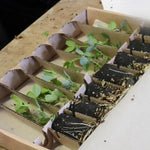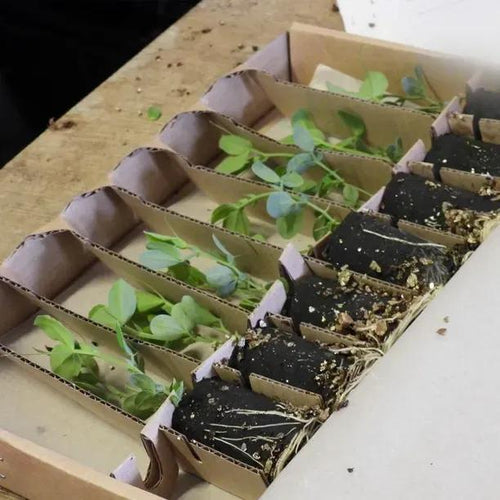'Erewhon' Sweet Pea Plants
Erewhon (Lathyrus odoratus x belinensis) caused quite a sensation when it was unveiled from Dr Keith Hammett's breeding programme in New Zealand. A Modern Grandiflora type, it has the best characteristics of both old and new varieties with more vigorous plants, bigger flowers and old-fashioned, heady scent.
It has a light pink standard and rich mid-blue wings - the opposite of standard sweet pea colouring. It has become a firm favourite with exhibitors at horticultural shows. Available as root-trained sturdy seedlings, Ashridge germinates and grows on the seeds for you, with garden-ready plants sent out at just the right time. Perfect for borders, pots and vases
Erewhon is such an unusual sweet pea that it needs to be a centre of attention, whether you plant it directly into the border or in pots. Place it near areas of heavy traffic near garden paths or next to doors (as long as it's in a sunny spot) so the scent can enter the house easily and the beauty of the flowers can be seen close-up. Avoid mixing it with a host of different-coloured blooms - the unusual petals will be lost. Try a setting of pure white and lilac lower level bedding, such as Surfinia and lavender or catnip, which will make the blooms shine out. Similarly, a backdrop of large, tropical-style leaves will enhance the intricacies of the flowers. Think non-variegated plants like Fatsia japonica, Rheum palmatum (ornamental rhubarb) or non-running bamboo such as Fargesia robusta Pingwu.
If you're growing it purely as a cut flower, keep deadheading daily so no seed pods can set. If you don't, the sweet peas will stop flowering. Remove any tendrils that will distort straight flower stems. Keep plants well tied in on a framework of canes for the maximum number of blooms. A drop of sugar syrup in the water of sweet peas will prolong their vase life.
Browse our sweet pea range.
Our Sweet Peas are delivered in purpose-designed, recycled cardboard packaging, and are ready to be planted out when you get them.
We generally send them out between March and May, but we will email you with the likely delivery timescale once you have placed your order.
Features
- Colour: Light pink and rich mid-blue
- Stem: Long
- Height: 1.8m
- Type: Modern Grandiflora
- Scent: Highly fragrant
- Flowering: June-September
- Planting Months: March-June
- Unique Lathyrus odoratus x L. belinensis cross
History & Trivia
Erewhon is a cross between an annual sweet pea (Lathyrus odoratus) and its close relative L. belinensis, only discovered growing in Turkey in 1987. It was thought that the latter's orange and yellow blooms could lead to a yellow sweet pea. However, when Dr Hammett started crossing the new Turkish plants with existing sweet peas blue came through instead.
Erewhon: or, Over the Range, is an 1872 novel by Samuel Butler, a satirical story about a sort of backwards world utopia, in the vein of Gulliver's Travels by Jonathan Swift, where sickness is a crime and crime is a medical condition.
Erewhon is an anagram of Nowhere, which is what utopia means.
Sweet peas are an ideal first flower to grow if you've just moved into a new-build house and the garden soil is impoverished. At the end of the season, cut off the plants at ground level but leave the roots in the soil - as a member of the pea (legume) family, sweet peas 'fix' nitrogen from the air in root nodules. From there, the nitrogen becomes available to other plants in the form of ammonia and nitrates the following season.

 Secure, One-Tap Checkout
Secure, One-Tap Checkout
 Hand Picked, Delivered to Your Door!
Hand Picked, Delivered to Your Door! 1 Year Bareroot Guarantee
1 Year Bareroot Guarantee




